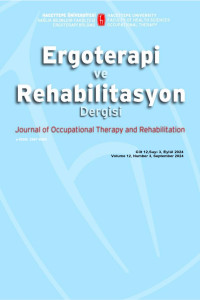Research Article
Issue Editorial Board



 0000-0002-8738-9594
0000-0002-8738-9594

Aim & Scope
The Journal of Occupational Therapy and Rehabilitation features scientific studies that include information, skills, and experiences aimed at improving personal and societal competence for individuals with impairments in body structure and function due to any health problems, those excluded from or restricted in participation within their social or cultural communities, as well as healthy individuals. These studies also cover intervention and rehabilitation approaches related to the field.
The Journal of Occupational Therapy and Rehabilitation publishes original research, review articles, case reports, technical notes, and letters to the editor in the field of occupational therapy. Articles are published after undergoing a double-blind peer review process.
Author Guidelines
Writing Guidelines
Manuscripts should be written on A4-sized pages using Times New Roman font, 12-point size, and double-spaced. Line numbers should be added to the text. Research articles should not exceed 5000 words, reviews 3000 words, case reports 2000 words, and letters to the editor 500 words. Articles should consist of the sections: introduction, materials and methods, results, and discussion. Case reports should be in the form of a structured abstract (Introduction, case presentation(s), and discussion). In letters to the editor, the title, issue, and date of the article being referred to should be mentioned, along with the name, institution, and address details of the author of the letter. No fee is paid to authors for published articles. Turkish articles should adhere to the Turkish Language Association (TDK) and the Turkish Scientific Terms Dictionary.
Scientific Responsibility and Ethical Issues
The scientific content and ethical compliance of the manuscripts are the responsibility of the author(s). Only articles with ethical committee approval are accepted by the journal. During the article submission process, the Ethical Committee Approval Document should be uploaded to the system. Authors must state in their manuscripts that informed consent was obtained from individuals participating in the research and should be able to document consent forms if necessary.
Title Page
The title page should include a descriptive title of the manuscript, the names of the authors, their titles, institutions, email addresses, ORCID information, and the corresponding author's contact address, email address, and phone number. If the article was previously presented, the date and place of the presentation should be specified. The title page should also include a section titled "Authors' Contribution," detailing each author's contribution to the research. Additionally, statements of "Conflict of Interest" and, if applicable, "Support/Acknowledgments" should be included. These details will be added to the end of the article during the layout stage. If the study was supported by an institution or BAP, this support should be acknowledged under the "Support" or "Acknowledgment" section. Furthermore, individuals who supported the research in stages such as data collection but are not listed as authors should be acknowledged. To clarify conflicts of interest, authors should declare whether there is any "Conflict of Interest."
Abstract and Keywords
The abstract should be prepared in both Turkish and English and should not exceed 200 words each. In research articles, the abstract should include the sections: purpose, material and method, results, and conclusion. In reviews and case reports, the abstract should be unstructured. Letters to the editor do not require an abstract. At the end of both Turkish and English abstracts, a minimum of 3 and a maximum of 5 keywords should be provided in Turkish and English. Keywords should be selected from the Turkish Scientific Terms (http://www.bilimterimleri.com).
English keywords should conform to "Medical Subject Headings (MeSH)" (www.nlm.nih.gov/mesh/MBrowser.html) and "BISAC Subject Headings" (http://www.bisg.org/what-we-do-20-73-bisac-subject-headings-2012-edition.php), and Turkish keywords should be translations of the MeSH terms. Keywords should be separated by semicolons (;).
Section Headings
The "Introduction" heading should not be used. The sections "Materials and Methods," "Results," "Discussion," and, if necessary, "Acknowledgment" should be included at the end.
References
Authors are responsible for the accuracy of the references. Journal name abbreviations should be written as they appear in the medical index of the journal. Abbreviations should not be made for journals that do not use them. References should be listed in alphabetical order. Examples of reference writing are provided below.
- Jones, M. W., Branigan, H. P., & Kelly, M. L. (2008). Visual deficits in developmental dyslexia: relationships between non-linguistic visual tasks and their contribution to components of reading. Dyslexia, 14(2), 95-115.
- Van Uffelen, J. G., Wong, J., Chau, J. Y., van der Ploeg, H. P., Riphagen, I., Gilson, N. D., et al. (2010). Occupational sitting and health risks: a systematic review. Am J Prev Med, 39(4), 379-388.
- Johnson, J. A. (1986). Wellness and occupational therapy. Am J Occup Ther, 40, 753-58.
- Rigby, L., & Wilson I. (2017). Occupational therapy interventions for someone experiencing severe and enduring mental illness. In C. Long, J. Cronin-Davis., & D. Cotterill (Eds.), Occupational Therapy Evidence in Practice for Mental Health, (Second Edition, pp.109-139). UK: WILEY Blackwell.
- Plonsky, M. (2004). Psychology with style: A hypertext writing guide (Version 5). Retrieved from the Web January 10, 2004. http://www.uwsp.edu/psych/apa4b.htm
- U.S. Department of Health, Education, and Welfare. (1971). Alcohol and Health. Washington, DC: U.S. Government Printing Office.
- Görsel Algı-Bilişsel Beceri (18. 9 2019). Erişim adresi: https://www.cognifit.com/tr/science/cognitive-skills/visual-perception.
- Kars S. (2018). 4-6 Yaş Arası Otizm Spektrum Bozukluğu Olan Çocukların Oyun Beceri ve Davranışlarının İncelenmesi (Yüksek lisans tezi). Hacettepe Üniversitesi Sağlık Bilimleri Enstitüsü, Ankara.
Tables, Graphs, and Photos
Tables, graphs, and photos should be included at the end of the manuscript, each on a separate page, numbered as referenced in the text. The names of tables, graphs, and photos should be indicated, and abbreviations should be appropriate. Images and photos should be submitted in JPEG format.
Ethical Principles and Publication Policy
Journal of Occupational Therapy and Rehabilitation ensures that all articles published within its scope meet high ethical and scientific standards. There are ethical guidelines that editors, reviewers, and authors must adhere to throughout the review process of articles submitted for publication in our journal.
These guidelines and required standards are based on the "Code of Conduct and Best-Practice Guidelines for Journal Editors" published by the Committee on Publication Ethics (COPE) (https://publicationethics.org) (http://publicationethics.org/files/Code_of_conduct_for_journal_editors_Mar11.pdf) and the "Uniform Requirements for Manuscripts Submitted to Biomedical Journals" published by the International Committee of Medical Journal Editors (http://www.icmje.org).
All submissions to our journal must comply with the following ethical considerations:
- For all studies requiring ethical committee approval involving humans or animals, approval must be obtained, and this approval must be stated in the methods section of the article with the name of the ethics committee, decision number, and date. This approval must also be documented during the article submission process. Detailed explanations of studies requiring ethical committee approval are listed below.
- In all research involving humans, informed consent must be obtained, and information about this consent must be included in the methods section of the article.
- There must be a statement in the article indicating compliance with Research and Publication Ethics during the planning and conduct of the study.
All the following types of studies require ethical committee approval:
- All kinds of research conducted using qualitative or quantitative methods requiring data collection from participants through surveys, interviews, focus group work, observation, experiments, and interview techniques.
- Research involving the use of humans and animals for scientific purposes in any context and scope.
- Clinical research on humans.
- Clinical research on animals.
- Retrospective studies using human data (e.g., file scanning) in accordance with the Law on Protection of Personal Data.
Editors' Responsibilities
Decisions regarding all articles submitted for publication are made jointly by the editor and area editors. These decisions must not be influenced by the authors' race, gender, sexual orientation, religious beliefs, ethnic origins, nationalities, or political views. The decision regarding an article is solely based on its scientific importance, relevance to the journal's scope, originality, use of valid and reliable methods, and clarity of content. The chief editor, area editors, and technical editors must not share information about the submitted articles with anyone other than the other editors, reviewers, and authors. During information sharing with reviewers, the authors' identities must not be disclosed under any circumstances. No information or material (e.g., visual, figure, schema) obtained from the content of an article under review can be used elsewhere without the explicit written permission of the authors, which must be shared where the material is used.
Reviewers' Responsibilities
The purpose of the peer review process is to assist the editor and associate editors in making decisions regarding the article, not to ensure its publication. To facilitate this decision-making, reviewers may provide improvement suggestions for the article. Reviewers must handle all articles and related documents with absolute confidentiality. They cannot share any part of the article or its content with anyone other than those authorized by the editor. In our journal, double-blind peer review is implemented, so authors and reviewers cannot know each other's identities. If a reviewer discovers or infers the author's identity, they must immediately notify the editor, and the reviewer will be replaced.
Reviewers must identify any problems related to referencing in the article. If a referenced publication is not cited in the bibliography, the reviewer must note this. Additionally, if the reviewer detects significant similarities between the reviewed article and other known publications, they must inform the editor. All reviews should be conducted impartially. Even if a reviewer has a specific opinion on a scientific concept, they must review an article on the same or a similar concept without bias. All evaluations and improvement suggestions must be based on objective criteria and not influenced by personal opinions.
Individuals invited to review must promptly inform the editor whether they can perform the review. If a reviewer who has accepted an invitation later finds they cannot complete the review promptly and effectively due to a new situation, they must inform the editor without delay.
Authors' Responsibilities
Authors of original research articles must include sufficient detail and references in the "methods" section to allow others to replicate the work. Fraudulent or knowingly inaccurate statements constitute unethical behavior and are unacceptable. In some cases, raw data may be requested from authors. When appropriate, data should be shared by the corresponding author with absolute anonymization.
Authors are responsible for producing entirely original works. If a submitted work is found to be not entirely original, the article will be rejected. Therefore, authors must create their articles originally and properly cite any expressions or sections taken from other publications. Submitting the same or substantially similar work for review in another journal while it is under review in our journal is unethical.
Authorship should be limited to those who have made significant contributions to the conception, design, execution, or interpretation of the reported study. All significant contributors should be listed as co-authors. Conversely, those who have not made significant contributions should not be listed as authors. The corresponding author is responsible for ensuring that all co-authors have reviewed and approved the final version of the paper and agreed to its submission for publication.
All authors must disclose any financial or other significant conflicts of interest that might be construed to influence their results or interpretations.
If an author discovers a significant error or inaccuracy in their published work, they must promptly notify the journal editor or publisher and cooperate with the editor to correct the paper or retract it.
Open Access Publication Policy
The Journal of Occupational Therapy and Rehabilitation provides immediate and uninterrupted open access to all articles within its content.
Open Access Licenses
The Journal of Occupational Therapy and Rehabilitation is licensed under the Creative Commons Attribution-NonCommercial 4.0 International License. To view a copy of this license, visit the link.
Price Policy
No fee is charged from the author or institution under any name.
Journal of Occupational Therapy and Rehabilitation by Hacettepe University, Faculty of Health Sciences is licensed under Attribution-NonCommercial 4.0 International

